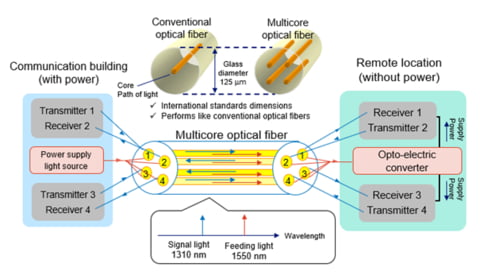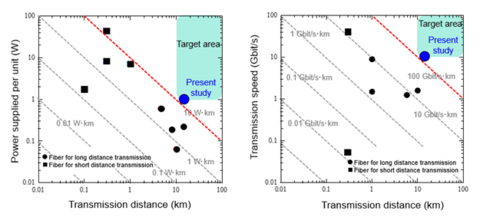TOKYO, Sept. 19, 2023 — The NTT Corp. and Kitami Institute of Technology (KIT) achieved a milestone in high-speed communications. The two organizations were able to deliver electric power exceeding 1 W to a remote location 10 km distant using a single optical fiber.
Optical communication technology and wireless access are essential for high-speed data communication. However, providing power to remote areas to establish base stations for radio access and optical communication transmitters and receivers remains a challenge. Additionally, natural disasters such as earthquakes, floods, fires, hurricanes, and typhoons may result in prolonged power outages, underscoring the need for rapid communication in affected regions.
Researchers have been investigating the transmission of communication and power supply signals through a single optical fiber to try to solve this problem. Traditional technology limited the distance over which power could be supplied to drive optical communication devices to under 10 km due to optical fiber input light intensity constraints, but with multicore optical fiber (MCF), high-capacity optical transmission could be done within the framework of innovative optical and wireless network (IOWN).

A graphic showing the optical feeding system using MCF. Courtesy of NTT.
The MCF employed in this research matches the thinness of existing optical fibers, with each core exhibiting transmission characteristics identical to those of standard optical fibers. As such, it can be seamlessly integrated with existing transmission equipment for conventional optical communication. Each core can function independently, avoiding optical signal interference between cores, and allowing for core allocation to power supply, communication, or both.
To maximize optical power supply, a 1550-nm wavelength light source was introduced into four cores. Additionally, two of the four cores were allocated both up and down signals with a wavelength of 1310 nm, facilitating bidirectional optical communication. The configuration allowed for two sets of two-core combinations, creating two separate communication systems.

Graphs portraying power supplied per unit and transmission speed over the transmission distance of the fiber optics. Courtesy of NTT.
After transmitting MCF over a distance of 14 km, approximately 1 W of power was obtained, which translates to an optical power supply capacity of 14 W/km. This also demonstrated bidirectional optical communication with a self-powered transmission rate of 10 Gbit/s. Assessing the product of transmission speed and distance as a performance indicator for self-powered transmission, this research achieved a performance of 140 Gbit/sec·km.
NTT and KIT hope that this research has the potential to pave the way for extending high-speed optical communication to underserved regions, including areas without electrical power, and establishing emergency communication methods through optical fiber in disaster-stricken situations.